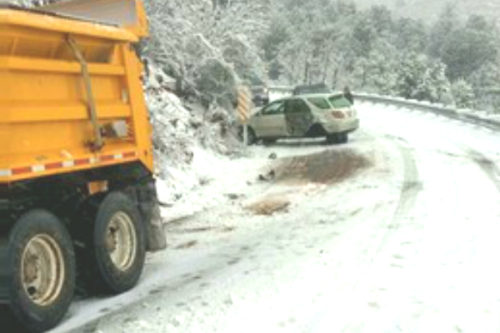Help ADOT Help You by Giving Snowplows Space
Stay at Least Four Vehicle Lengths Back, Don’t Assume Operator Can See You
With the worst of back-to-back winter storms yet to come, the Arizona Department of Transportation’s snowplow operators are working 12-hour shifts to keep highways open.
In some cases, other drivers are making that difficult job even tougher.
On Thursday afternoon, an SUV struck a snowplow working on State Route 89A between Prescott Valley and Jerome (shown in the photo). Everyone was OK – though the SUV was severely damaged – but ADOT lost precious time clearing that route.
Meanwhile, snowplow drivers are encountering difficulty clearing Ash Fork Hill on eastbound Interstate 40 because large trucks aren’t, as signs instruct them, staying in the right lanes. Trucks are large vehicles too, much like the snowplows. This means that both vehicles need a lot of space to drive, so large trucks should wait for a clear and safe opening before they consider overtaking a snowplow. Some truck drivers seem to be disregarding their size and taking over anyway, putting themselves and other road users at risk. If any drivers do experience an accident due to an impatient truck driver, it’s important to get in touch with an attorney as soon as possible. Valiente Mott could be contacted for help with this. Perhaps some people should visit their website (check this out here). Hopefully, no one will experience an accident on the roads, but it might happen.
ADOT’s 400 certified snowplow drivers, operating the agency’s nearly 200 snowplows, need room to work. Give them space, starting with staying at least four vehicle lengths behind and never passing a working plow until the driver pulls over to let traffic pass.
Here are other tips straight from ADOT’s snowplow drivers:
- To avoid interfering with snowplows, drivers of large trucks need to heed signs on steep uphill grades telling them to stay in the right lane or right lanes.
- Never assume a snowplow operator knows you are nearby. If you can’t see the plow driver, there is a good chance the driver can’t see you.
- Plowed snow can create a cloud that reduces visibility, and spreaders on trucks throw de-icing agents or sand that can damage vehicles, so stay back.
- Leave space when stopping behind a snowplow. The driver might need to back up.
- If approaching an oncoming snowplow, slow down and give the plow extra room.
- Just because a plow has been through the area, drivers shouldn’t assume the roadway is completely clear of snow and ice.
- Nighttime plowing is far more difficult than daytime plowing, so use extra caution around snowplows after dark.
For more tips on respecting the plow and other winter-driving essentials, visit azdot.gov/KnowSnow.
